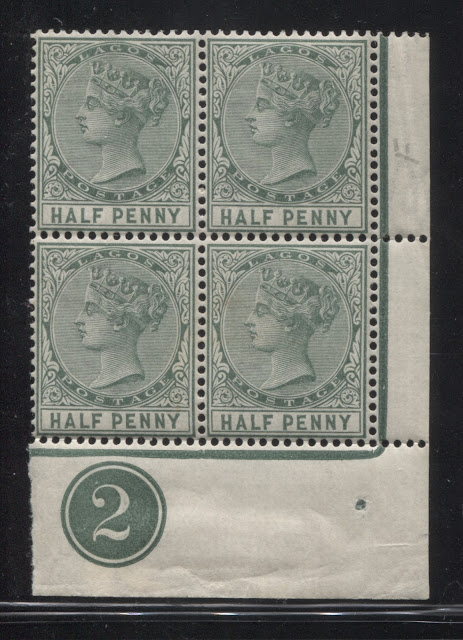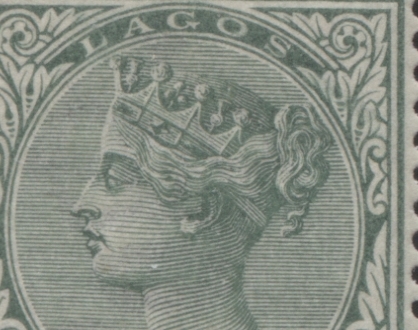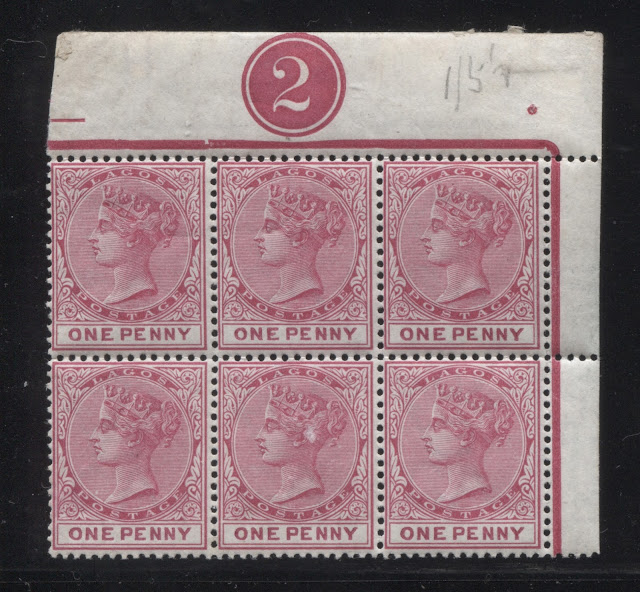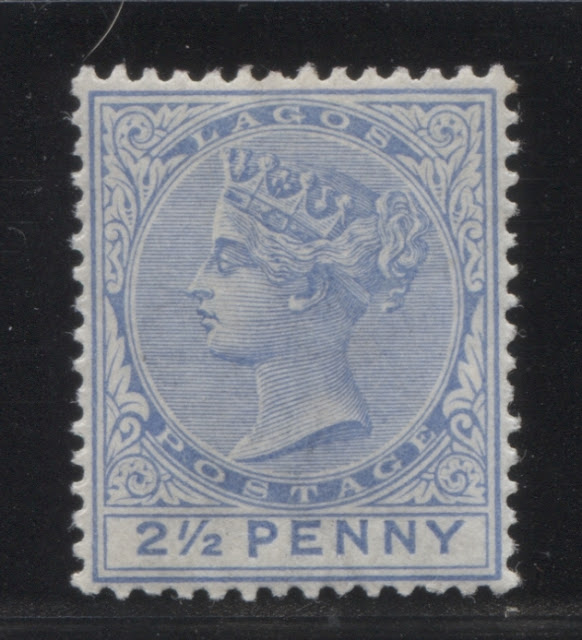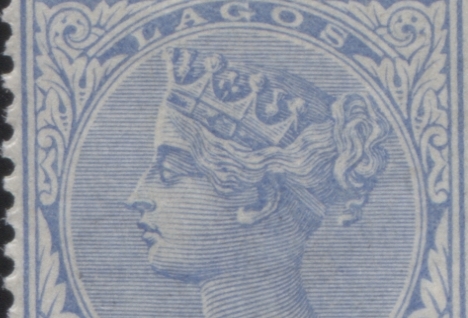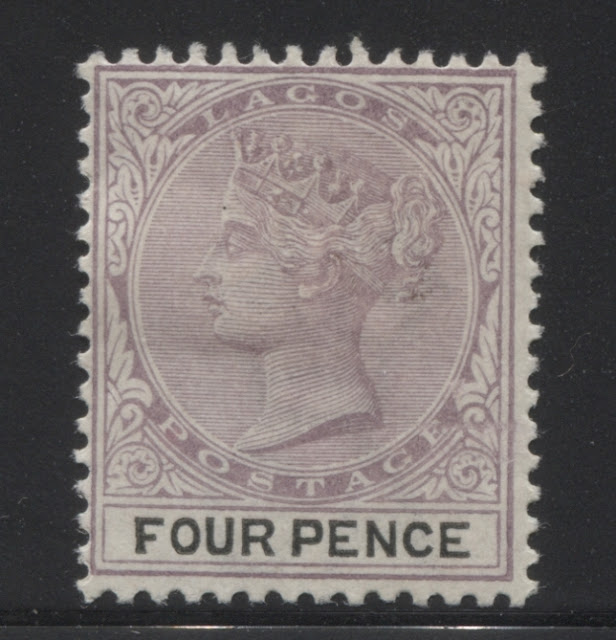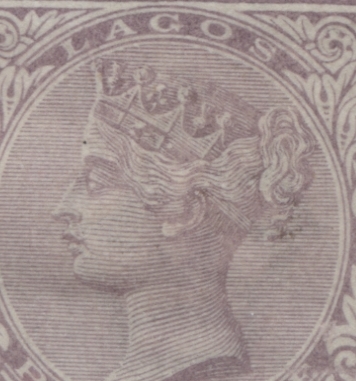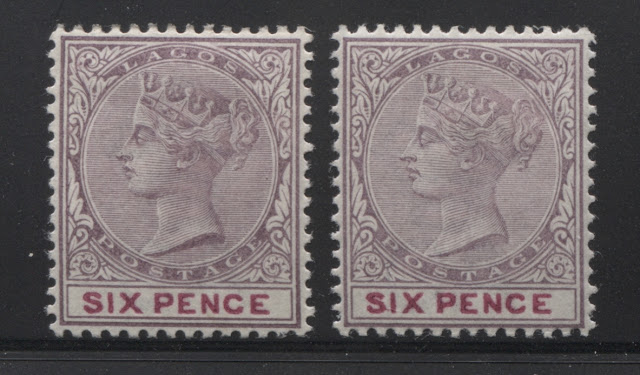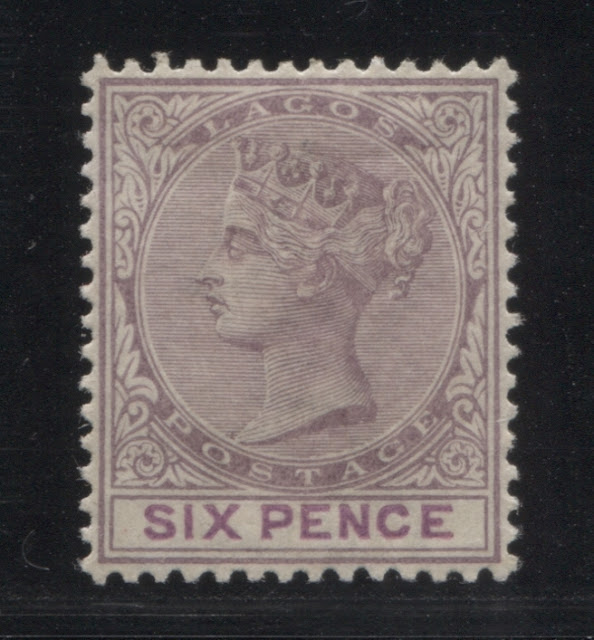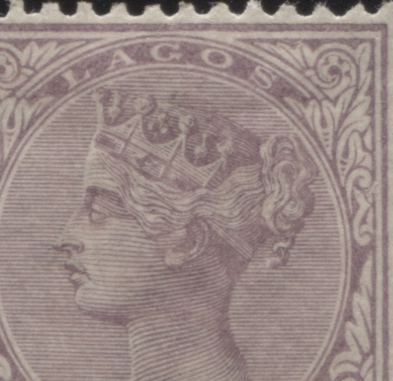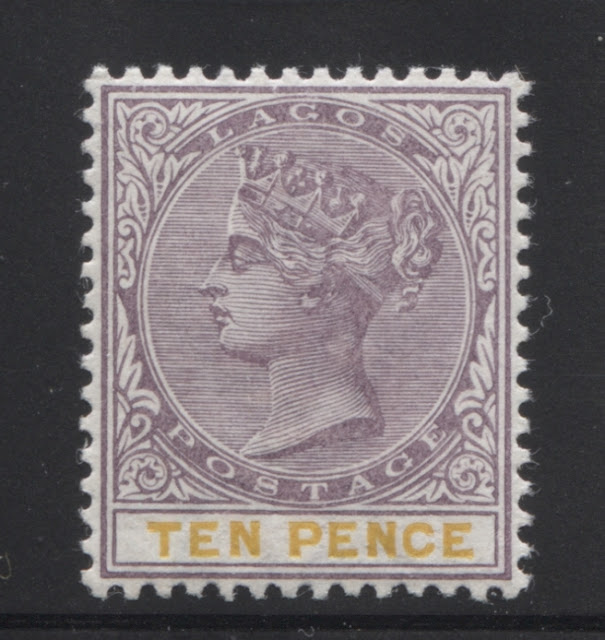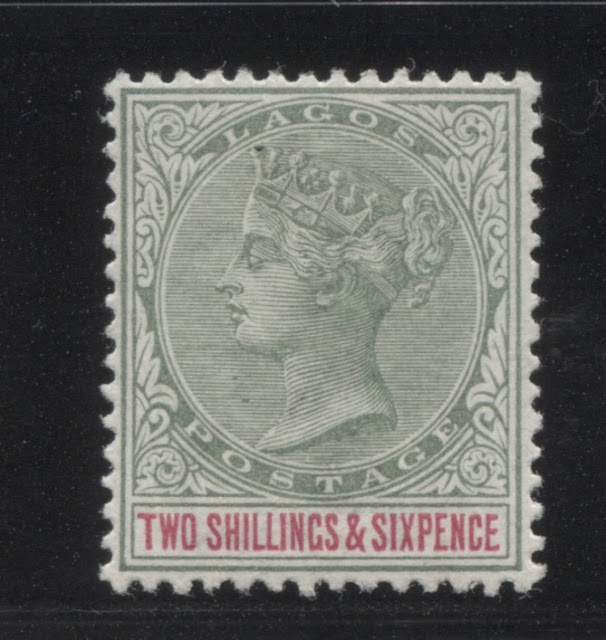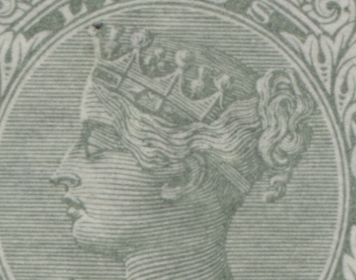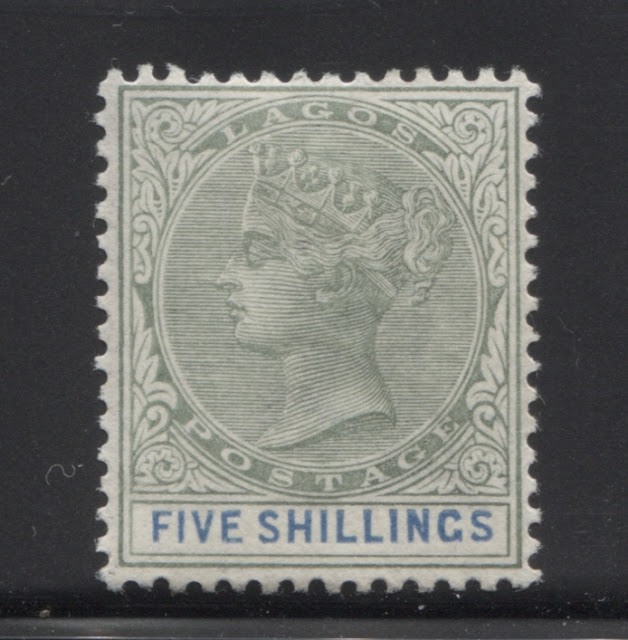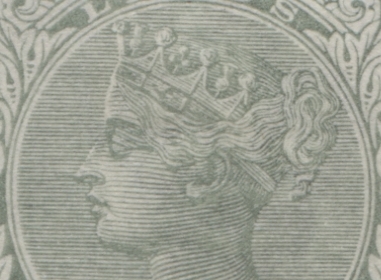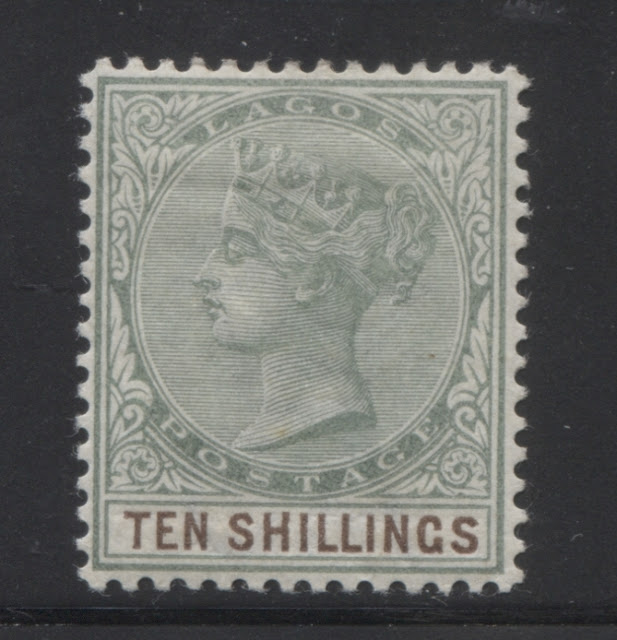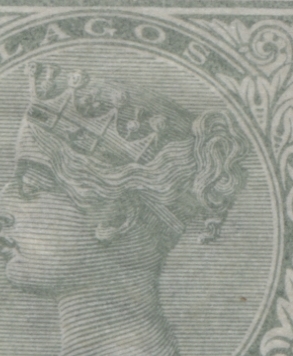Overview
According to Ince, plate 2 was first brought into use for the printings sent out on August 19, 1901, and was used to produce a second printing that was sent out on August 29, 1902. According to him, it was only used to print two printings each of the halfpenny and 1d, as well as one printing each of the 1/- and 6d. However, given that the other values had printings sent out on August 19, 1901, it seems quite likely that the very last printings of the 2d, 2.5d, 3d, 4d, 5d, 7.5d, 10d, 2/6d, 5/- and 10/- were also made from this plate. To settle this question once and for all is the first step in sorting the remaining printings of the Lagos Queen Victoria Keyplates that were made between 1887 and 1903.
Ince notes a few characteristics of these printings to enable positive identification:
This is a pale ultramarine, and appears at least to me, to have been a printing made using the larger duty plate. It has the thin, smooth cream gum normally associated with printings from this period.
According to Gibbons, this printing was released in October 1902, which would have corresponded with a dispatch date of August 1902, so it was likely the second printing made from plate 2, which would suggest that there may have been a first printing from August 1901. The defining characteristic of this printing is the duty plate colour, which is a bright aniline magenta (Ince calls it carmine). There is some slight variation in the intensity of the mauve frame plate colour, though not quite enough to suggest a different printing.
As you can see from this close-up scan, there is some very minimal merging of shading lines at the top of the head, but any and large, the detail is very clear, and is much, much clearer than what would usually be seen from stamps printed in 1893, as evidenced by the fact that it is clearer and crisper than the earliest printings that I examined of the 5d and 7.5d stamps. So there is a very good chance that this is an example of the August 1901 printing made from plate 2.
According to Ince, plate 2 was first brought into use for the printings sent out on August 19, 1901, and was used to produce a second printing that was sent out on August 29, 1902. According to him, it was only used to print two printings each of the halfpenny and 1d, as well as one printing each of the 1/- and 6d. However, given that the other values had printings sent out on August 19, 1901, it seems quite likely that the very last printings of the 2d, 2.5d, 3d, 4d, 5d, 7.5d, 10d, 2/6d, 5/- and 10/- were also made from this plate. To settle this question once and for all is the first step in sorting the remaining printings of the Lagos Queen Victoria Keyplates that were made between 1887 and 1903.
Ince notes a few characteristics of these printings to enable positive identification:
- Continuous jubilee lines in the sheet margins, where no jubilee lines appear on the earlier printings.
- Plate numbers in all four corners of a sheet, as opposed to just two corners.
- A printing impression that is completely clear and shows no signs of wear whatsoever.
- Thicker duty plate lettering on the 1/2d and 1d.
The second characteristic is of little practical use, as there are no intact sheets in existence that I am aware of. The most useful characteristic by far though will be the clarity of the printing impression, as any printing from plate 2 will show none of the wear that the plate 1 printings exhibited by this time. I will then rely on shade differences and the other characteristics to separate the two printings where there were two printings made.
The Halfpenny Green
The above scan shows the first printing made from plate 2, which was sent out in August 1901. The colour is an unmistakable deep green, whit stands in sharp contrast to the dull, and greyish greens found on the printings from the 1890's through to 1900. You can see the continuous green jubilee line that Ince mentions in his work that borders the stamps in the sheet, and is a clear characteristic of stamps printed from plate 2. On this printing, the head plate and duty plate colours are both the same.
Here is a close up of the vignette of a stamp from that block. Here you can see that all the detail of the hair and diadem are clear, with no signs of plate wear. The horizontal background lines appear even and evenly spaced.
The next scan shows a block of 16 of the second printing from plate 2 that was sent on August 1902:
Again, the colour is deep green for the head plate. However the duty plate is an even darker Myrtle green. Note the thick bold letters of the duty plate.
The 1d Carmine
This scan shows what I believe to be the first printing of the 1d carmine from plate 2, showing the plate number and characteristic jubilee line. The head plate and duty plate colour is different for both printings made from plate 2. On this printing, the head plate colour is a bright carmine, with very little bluish undertone, while the duty plate colour is deep crimson, with an almost aniline quality.
Here is a close-up of one stamp from the block above. Again, substantially all of the detail of the hair and diadem is crisp and clear, with no sign of plate wear.
I believe this block to be the second printing of the 1d that was sent to the colony in August 1902. The duty plate colour is still deep crimson, but this time the head plate colour is a carmine that contains more of a bluish undertone.
2d Mauve and Ultramarine
In examining close to 100 examples of this stamp, I was not able to find any that exhibited the clarity that would normally be associated with a plate 2 stamp. There were some that were close to what we would normally associate with plate 2, but they were much closer to the early state of plate 1 and they had the colours and gum that placed them in the period from about 1887 to 1890. So my preliminary conclusion is that there were no plate 2 printings of this value.
2.5d Ultramarine
I looked at well over 130 examples of this stamp in search of one that could be from plate 2. I found one that shows very clear detail, as well as gum characteristics consistent with printings made in August 1901. I don't feel that it can be an early printing from 1891, as the colours don't seem consistent with that period, and the vignette would have shown more signs of wear by the time the very first printings were made in 1891:
This is a pale ultramarine, and appears at least to me, to have been a printing made using the larger duty plate. It has the thin, smooth cream gum normally associated with printings from this period.
Here is a close-up of the vignette that shows the same clarity of detail that we just saw in the 1/2d and 1d stamps. It is therefore plausible to me that there was a printing made in August 1901, and that this is an example of it.
3d Mauve and Chestnut
Out of almost 90 mint and used examples of this stamp, I was unable to find any that possessed the crispness and clarity of a plate 2 stamp. Thus it would appear that there were no printings of this stamp from plate 2.
4d Mauve and Black
I have close to 80 mint and used examples of this stamp. Out of them all, I was only able to locate one that I feel could be the August 1901 printing, and could have come from plate 2:
Like the earlier stamps, this one has the thin cream gum that the other stamps have. It is not quite as crisp, but it is much crisper than any of the stamps I looked at, including the specimens, which would have been produced in 1887.
As the close-up scan shows, this is not quite as crisp as the other scans, so there is a possibility that it is an 1887 printing. However, I think there is a good chance that it is actually an August 1901 printing.
5d Mauve and Dark Green
In examining over 60 mint and used examples of this value, I was not able to find an example that showed the clarity that I would normally associate with a plate 2 stamp. Thus, my tentative conclusion would be that there were no plate 2 printings of this value.
6d Mauve and Aniline Magenta
According to Gibbons, this printing was released in October 1902, which would have corresponded with a dispatch date of August 1902, so it was likely the second printing made from plate 2, which would suggest that there may have been a first printing from August 1901. The defining characteristic of this printing is the duty plate colour, which is a bright aniline magenta (Ince calls it carmine). There is some slight variation in the intensity of the mauve frame plate colour, though not quite enough to suggest a different printing.
The above is a close-up of the vignette of one of the stamps that shows that nearly all the detail of the hair and diadem is clearly visible and shows no signs of plate wear.
I did manage to find one stamp, which may well be an August 1901 printing from plate 2:
The duty plate of this stamp is purple, which is moving towards the aniline magenta, and the lettering is certainly thicker than the lettering normally seen on the earlier printings. The head plate colour is a paler mauve. The gum is thin and colourless - similar to that seen on the other stamps.
As this close-up scan shows, there is not much difference between the degree of clarity here, and the August 1902 printing shown above. Thus, I feel it is safe to conclude that this is an example of the August 1901 printing, and is more than likely made from plate 2.
7.5d Mauve and Carmine
In examining over 50 mint and used examples of this value, I was not able to find an example that showed the clarity that I would normally associate with a plate 2 stamp. Thus, my tentative conclusion would be that there were no plate 2 printings of this value.
10d Mauve and Yellow Orange
In examining over 50 mint and used examples of this stamp in my stock, I was not able to find an example that shared the characteristics of the other stamps for plate 2. The closest I was able to find, which might be a plate 2 is this stamp:What suggests to me that this might be plate 2 is the depth and freshness of colour, combined with the clarity of the design. All the other stamps I examined of this value, along with the other stamps issued at the same time, being the 5d and 7.5d, showed definite plate wear. This is the only one that shows very little sign of wear, and the merging of lines that is apparent could simply be due to heavy inking. The gum is consistent with printings made during this time, which is another factor that suggests that it may be a plate 2 printing.
As you can see from this close-up scan, there is some very minimal merging of shading lines at the top of the head, but any and large, the detail is very clear, and is much, much clearer than what would usually be seen from stamps printed in 1893, as evidenced by the fact that it is clearer and crisper than the earliest printings that I examined of the 5d and 7.5d stamps. So there is a very good chance that this is an example of the August 1901 printing made from plate 2.
1/- Yellow Green and Black
This example of the 1/- in shade of dull yellowish green and black is clearly an example of a plate 2 printing. I was only able to find one printing from this plate, which leads me to conclude that August 1901 was the date of the last printing. I don't show a close-up scan, as you can see very clearly from this scan that all of the finer details are visible and clear.
2/6d Green and Carmine
Here is an example of the 2/6d in a shade of dull green and carmine. The clarity of the printing impression, combined with the characteristics of the gum, suggests quite strongly that this is an example of the August 1901 printing, and that it likely was made from the new plate 2.
As you can hopefully see from the close-up scan shown here, the clarity of this stamp is on a par with the known plate 2 examples of the halfpenny and 1d.
5/- Green and Ultramarine
Again, after looking at over 20 copies of the 5/- that are in my stock, I was able to find one that I feel may well be an example of the August 1901 printing. Once again, the degree of clarity of the printing impression suggests that it is indeed from plate 2 and not plate 1.
Admittedly this is not as crisp as the known plate 2 printings of the 1d and halfpenny, but it is just as clear. For sure, if this is not the 1901 printing, it would have to be from 1887, which is a possibility, though I don't consider it likely.
10/- Green and Brown
This example of the 10/- has the same deep green colour of the halfpenny and a very deep and vibrant violet brown, which does suggest to me that it is an example of the August 1901 printing. The gum is certainly consistent with that of the known plate 2 printings.
Again, this close up scan of the vignette shows the same degree of clarity and crispness that is associated with the other plate 2 printings.
Conclusion
I believe based on the above stamps and my examination of the other values that plate 2 was used for all of the August 1901 printings, with the exception of just a few of the values, being the 2d, 3d, 5d and 7.5d, and it is possible that they exist and I simply do not have them. One of the reasons why they may be so difficult to find is that they made up the bulk of the remainders that were destroyed, so that they might actually be scarcer than the earlier printings, despite being printed in larger numbers. One of the reasons why prominent students like Ince believe that only the 1/2d, 1d, 6d and 1/- were issued thus might be that these are the only denominations for which they were able to find plate blocks showing either the plate number, or continuous jubilee lines. The other values are probably just too scarce to have survived in these kinds of multiples. Nonetheless, I do think that most of the values of this set were printed from this new plate.
This concludes my discussion of the plate 2 printings from August 1901 to 1903. Next week, I will be looking at the printings of the 5d mauve and dark green, made from 1893 to 1901.


